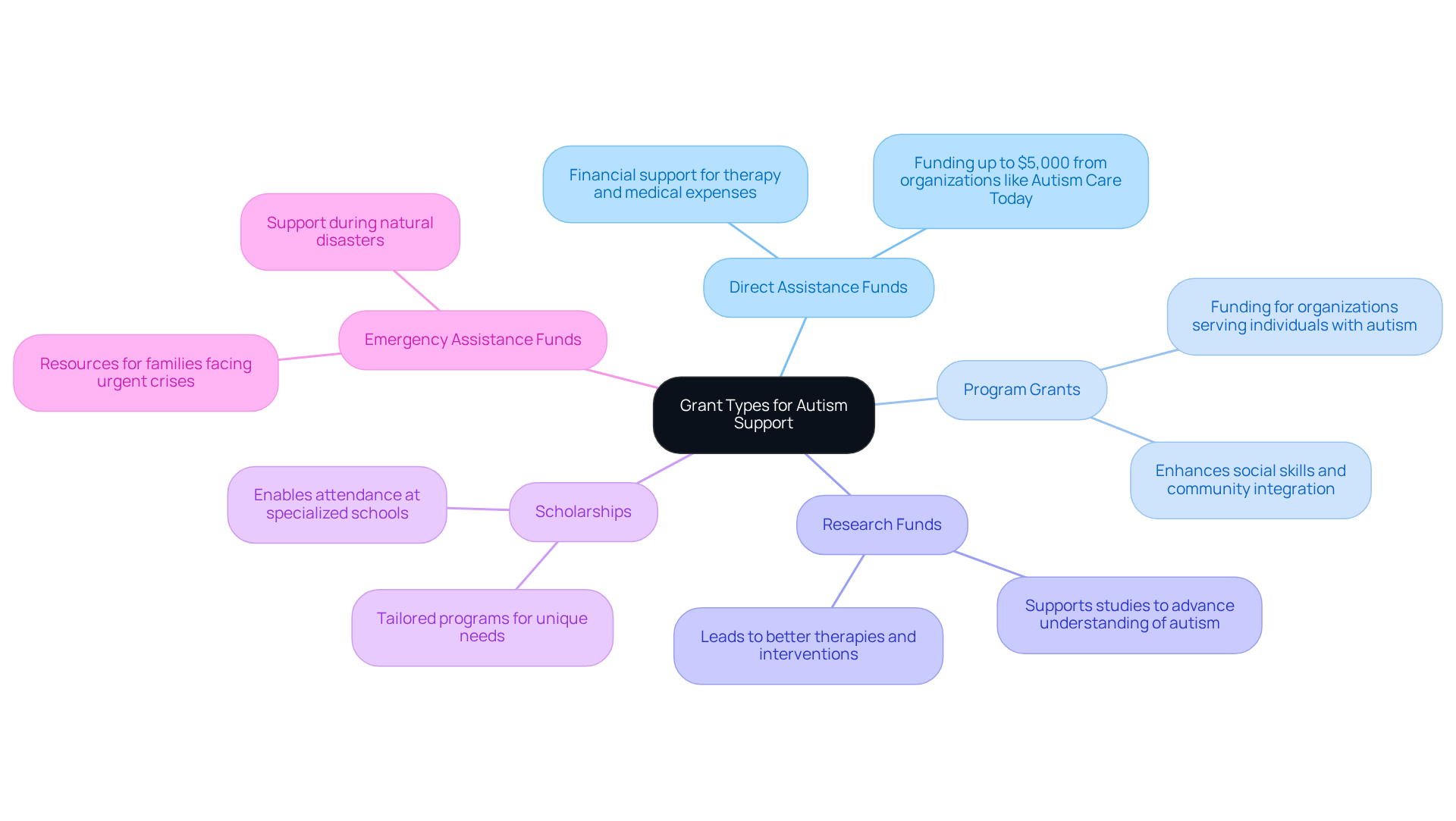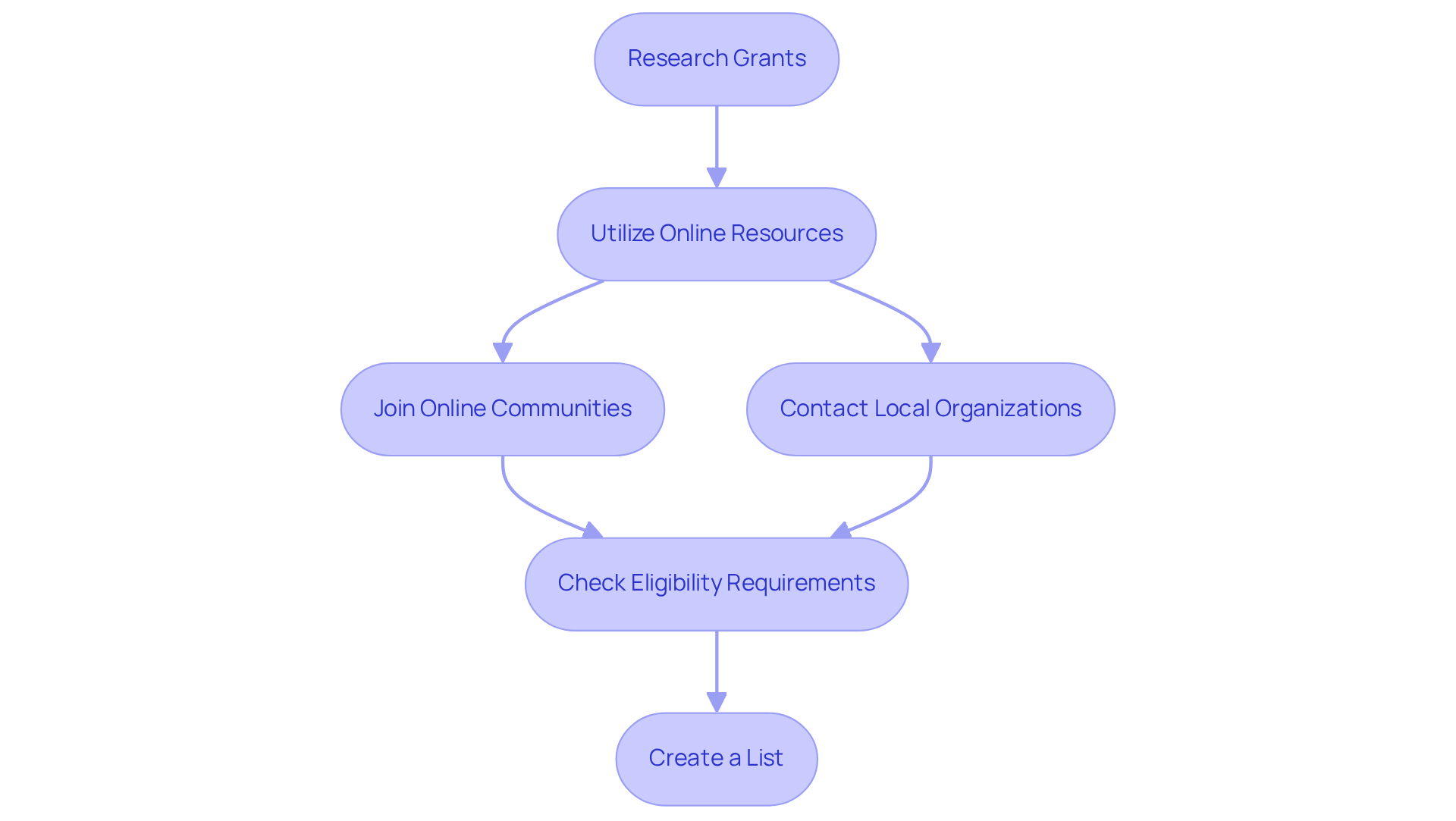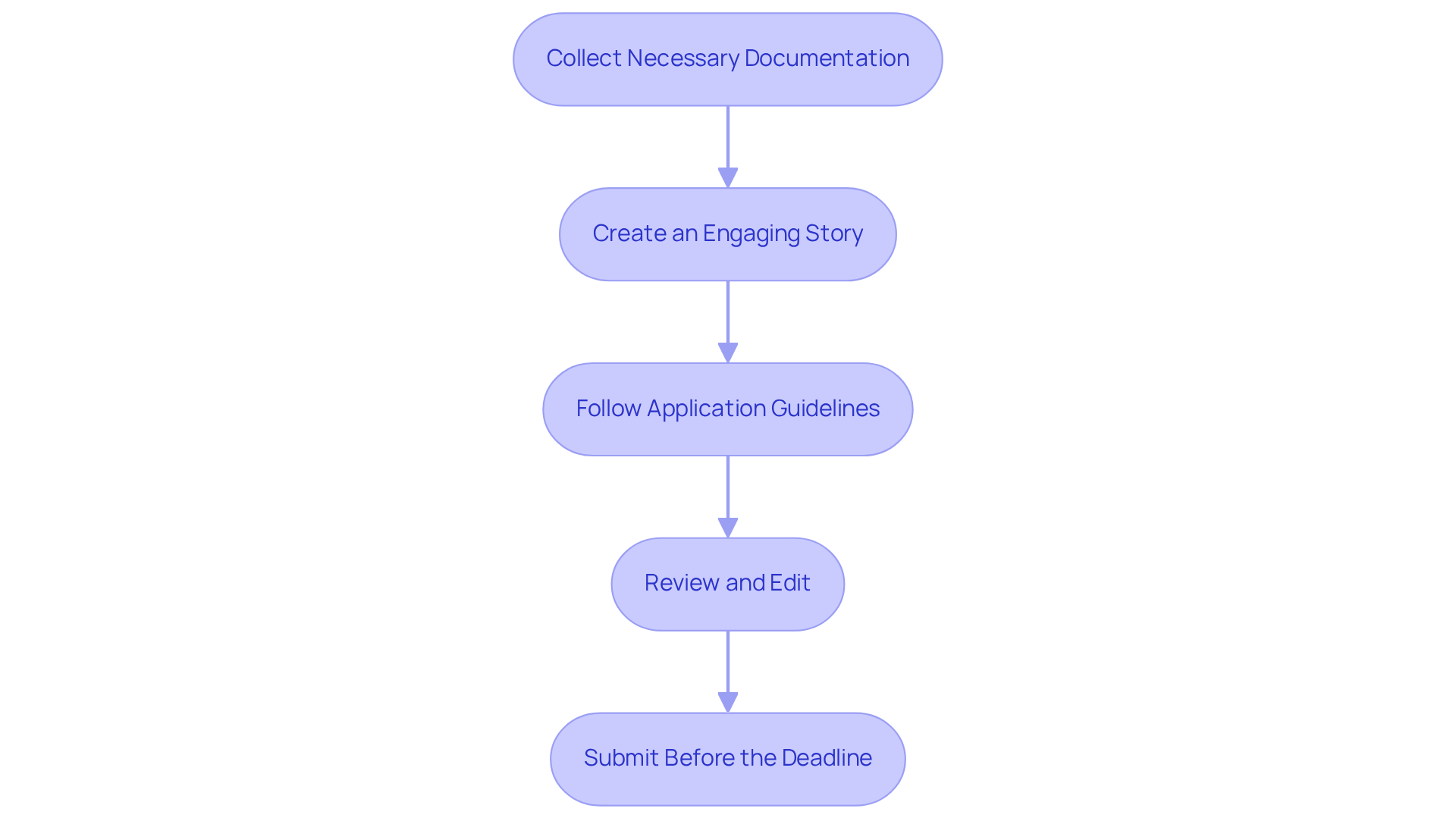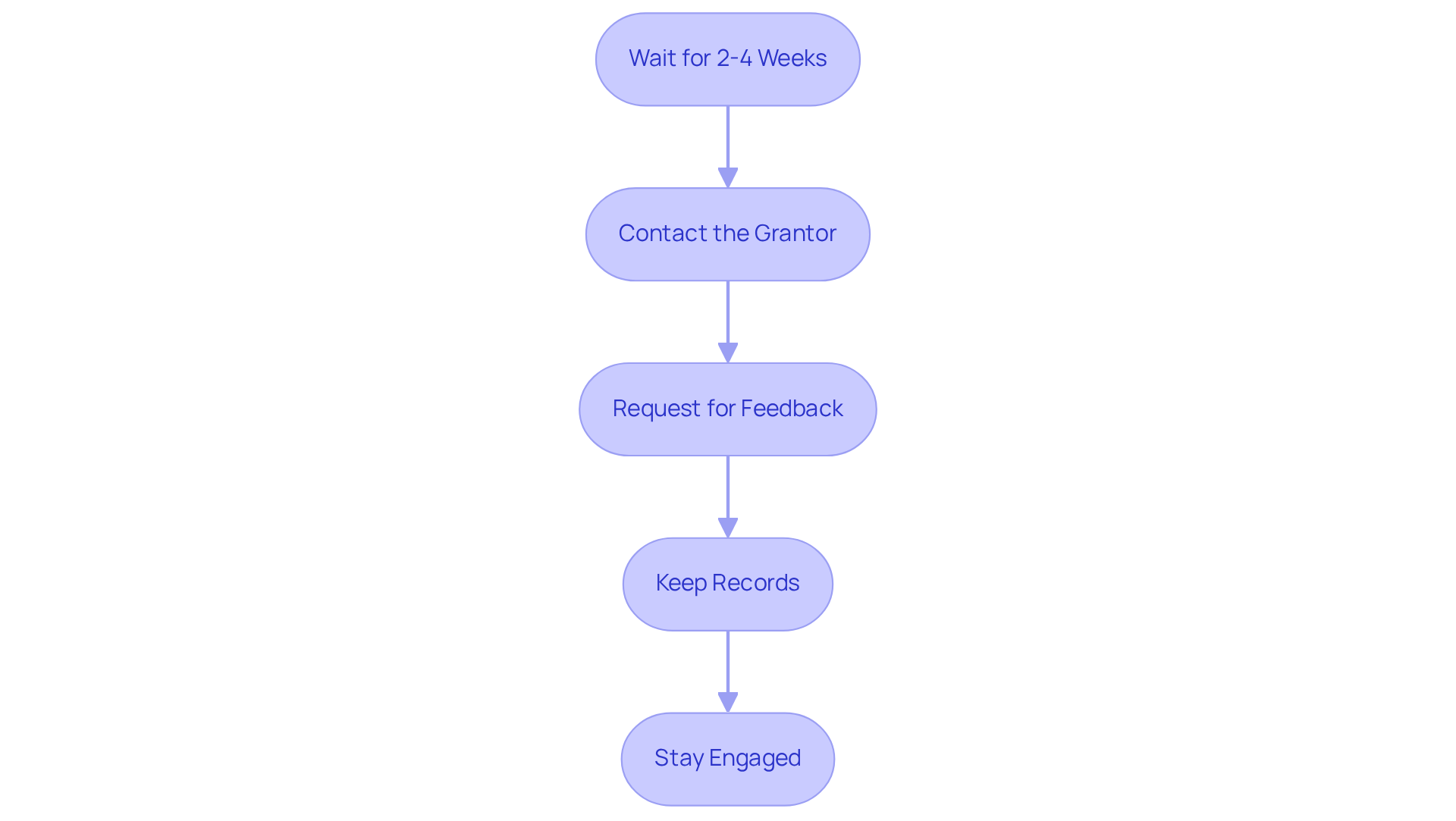Overview
Navigating the world of grants for children with autism can feel overwhelming, but understanding the process can make a significant difference. This article outlines four essential steps to help you secure the financial support your child needs.
-
Familiarize yourself with the different types of grants available. Knowing your options is crucial in finding the right fit for your family's unique situation.
-
Next, take the time to research suitable grant opportunities. This step is not just about finding funding; it’s about discovering resources that align with your child's needs. As you delve into this process, consider sharing your experiences with other parents—your insights could be invaluable to someone else.
-
Once you've identified potential grants, prepare and submit your applications with care. This is where thorough preparation pays off. Each application is a chance to tell your child's story and highlight their strengths. Remember, grantors appreciate a personal touch, so don’t hesitate to share your journey.
-
Finally, following up on your submissions is key. A gentle nudge can go a long way in demonstrating your commitment and eagerness for support. By engaging proactively with grantors, you enhance your chances of receiving the assistance you seek.
Throughout this journey, remember that you are not alone. Each step you take is a testament to your dedication as a parent. Embrace the resources and support available, and don’t hesitate to reach out to your community for guidance and encouragement.
Introduction
Navigating the complex landscape of grants for children with autism can feel overwhelming for many families. By understanding the various types of funding available—from direct assistance to scholarships—families can unlock vital resources that significantly enhance the quality of life for their children. Yet, with so many options and the intricacies of the application process, how can families ensure they don’t miss out on essential support? This guide offers a clear, step-by-step approach to securing grants, empowering families to access the assistance they need while overcoming common challenges along the way.
Understand Available Grant Types for Autism Support
Navigating the world of grants for kids with autism assistance can feel overwhelming, but understanding the different types available can empower families in their journey. Here are some common categories that might resonate with your needs:
- Direct Assistance Funds: These funds provide crucial financial support directly to families, helping cover therapy, educational resources, or medical expenses. For instance, organizations like Autism Care Today and ACT Today offer funding up to $5,000, making a significant difference in the lives of many.
- Program Grants: Designed for organizations that serve individuals with autism, these grants fund programs that enhance social skills, educational opportunities, and community integration. They play a vital role in creating supportive environments for growth.
- Research Funds: Aimed at advancing our understanding of autism, these funds support studies that can lead to better therapies and interventions. The knowledge gained can be transformative for families seeking effective solutions.
- Scholarships: Some organizations offer scholarships specifically for children with autism, enabling them to attend specialized schools or programs tailored to their unique needs.
- Emergency Assistance Funds: These resources are invaluable for families facing urgent crises, such as natural disasters, which can disrupt their ability to care for a child with autism.
By comprehending these categories, you can navigate the funding landscape more effectively, ensuring that you access grants for kids with autism that are needed for your family. Remember, you are not alone in this journey—there are resources and communities ready to help.

Research and Identify Suitable Grants
To effectively secure grants for autism support, it's essential to embrace a few thoughtful steps:
- Utilize Online Resources: Start by exploring valuable websites like Autism Speaks, ACT Today, and the Autism Science Foundation. These platforms provide extensive lists of grants for kids with autism, along with crucial details on eligibility requirements and application procedures. This simplifies the journey through financial opportunities. In 2025, thousands of grants for kids with autism will be released weekly, ensuring that families in need have access to a wealth of resources.
- Join Online Communities: Connecting with forums and social media groups dedicated to autism assistance can be incredibly beneficial. Engaging in these communities allows you to gather valuable insights, as members often share information about grants for kids with autism and other financial support opportunities that might not be widely known.
- Contact Local Organizations: Don’t hesitate to reach out to local autism assistance organizations or advocacy groups. These entities often have knowledge of local funding opportunities, such as grants for kids with autism, that may not be well-promoted online, providing a more personalized approach to obtaining financial support. For instance, the United Healthcare Children's Foundation has made a significant impact by offering essential financial assistance to families, ensuring they can access necessary medical care.
- Check Eligibility Requirements: It’s vital to carefully review the eligibility criteria for each funding opportunity. Some funds may be income-based, while others might require specific documentation related to your child's diagnosis. Understanding these requirements is crucial for successfully navigating the application process for grants for kids with autism.
- Create a List: Consider compiling a detailed list of potential grants, including their deadlines, funding amounts, and specific requirements. This organized strategy will help streamline your application process for grants for kids with autism and ensure that you meet all necessary criteria.
By implementing these strategies, families can significantly enhance their chances of securing the support they need. As one grateful funding recipient shared in 2023, 'Thank you for taking the time to listen to us each time.' Your time spent reviewing our needs and necessities is genuinely appreciated.

Prepare and Submit Grant Applications
When preparing your grant application, it's important to approach the process with care and consideration. Here are some steps to guide you:
- Collect Necessary Documentation: Most funding opportunities require evidence of diagnosis, financial details, and insights into how the funds will be utilized. Make sure you have all necessary documents organized and ready to go.
- Create an Engaging Story: Take the time to clearly express your family's needs and illustrate how the funding will make a meaningful impact. Specific examples can powerfully convey the effects of autism on your daily life and highlight the potential benefits of receiving grants for kids with autism support.
- Follow Application Guidelines: Each grant comes with its own set of instructions regarding format, length, and submission methods. It’s crucial to adhere strictly to these guidelines to avoid any risk of disqualification.
- Review and Edit: Before hitting submit, review your application for clarity and completeness. It can be incredibly helpful to have someone else read it as well, providing valuable feedback from a fresh perspective.
- Submit Before the Deadline: Aim to submit your request well in advance of the deadline to sidestep any last-minute complications. Don’t forget to keep a copy of your submission for your records.
Remember, this process can be daunting, but you’re not alone. Each step you take is a move toward securing the support your family needs.

Follow Up on Grant Applications
After submitting your grant application, it’s important to follow these essential steps to ensure you’re on the right track:
- Wait for the Appropriate Time: Allow a reasonable period, typically 2-4 weeks, for the grantor to review submissions. This timeframe respects their process and ensures you are not prematurely reaching out.
- Contact the Grantor: When the time feels right, reach out via email or phone to inquire about the status of your request. Maintaining a polite tone and expressing gratitude for their consideration can reinforce a positive impression.
- Request for Feedback: If your submission is unsuccessful, kindly ask for insights on areas for enhancement. This constructive criticism can be invaluable for improving future submissions and increasing your chances of success.
- Keep Records: Document all communications with grantors, including dates and details of conversations. This organized approach will help you track your applications and follow-ups effectively.
- Stay Engaged: Once you receive financial support, keep the grantor informed about how the resources are utilized. Frequent updates can enhance your relationship and create pathways for future funding opportunities.
Incorporating these strategies is crucial, especially considering that foundation giving accounts for approximately 19% of total philanthropy. Engaging effectively with grantors can significantly improve your chances of obtaining financial support. As grant consultant Veronica Kulon notes, understanding the dynamics of donor-advised funds (DAFs) and impact-oriented giving is essential for navigating the current philanthropic landscape. For instance, organizations that have successfully followed up on their applications often report improved relationships with grantors, leading to increased funding opportunities in subsequent cycles.

Conclusion
Understanding the landscape of grants for children with autism is crucial for families seeking support. By recognizing the various types of funding available—such as direct assistance, program grants, and scholarships—families can effectively navigate resources that can significantly enhance their child's quality of life. This guide offers a structured approach to securing these vital grants, ensuring that families are equipped with the knowledge and tools necessary to access essential support.
Key insights include:
- The importance of researching suitable grants through online platforms
- Engaging with local organizations
- Meticulously preparing grant applications
Each step, from identifying the right funding opportunities to following up on applications, plays a pivotal role in enhancing the chances of success. Families are encouraged to remain organized and proactive throughout the process, which can lead to fruitful outcomes in securing financial assistance.
Ultimately, the journey to obtaining grants for autism support transcends mere paperwork; it is about empowering families to provide better opportunities for their children. By taking action and utilizing the resources available, families can unlock the potential for growth and development that grants can offer. Embracing this process can lead to transformative changes, underscoring the importance of persistence and community support in the quest for funding.
Frequently Asked Questions
What are the different types of grants available for autism support?
The main types of grants for autism support include Direct Assistance Funds, Program Grants, Research Funds, Scholarships, and Emergency Assistance Funds.
What do Direct Assistance Funds provide?
Direct Assistance Funds offer financial support directly to families to help cover therapy, educational resources, or medical expenses. Organizations like Autism Care Today and ACT Today provide funding up to $5,000.
What are Program Grants used for?
Program Grants are designed for organizations serving individuals with autism, funding programs that enhance social skills, educational opportunities, and community integration.
What is the purpose of Research Funds in the context of autism?
Research Funds aim to advance the understanding of autism by supporting studies that can lead to better therapies and interventions for families seeking effective solutions.
How do Scholarships assist children with autism?
Scholarships are offered by some organizations specifically for children with autism to enable them to attend specialized schools or programs tailored to their unique needs.
What are Emergency Assistance Funds, and why are they important?
Emergency Assistance Funds provide resources for families facing urgent crises, such as natural disasters, which can disrupt their ability to care for a child with autism.




